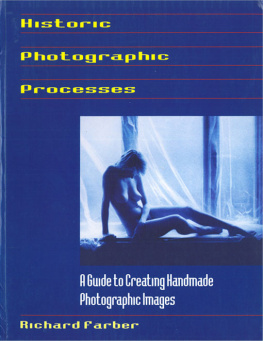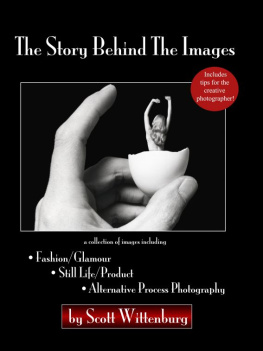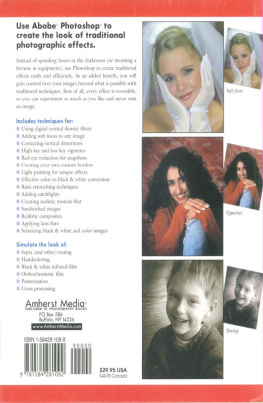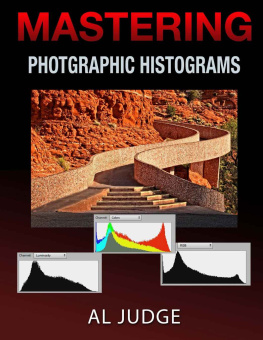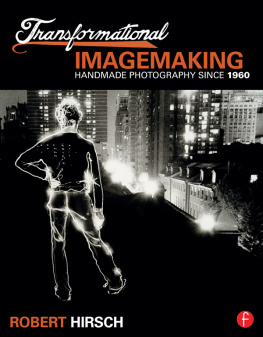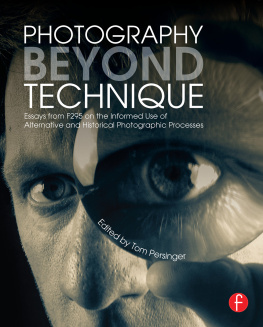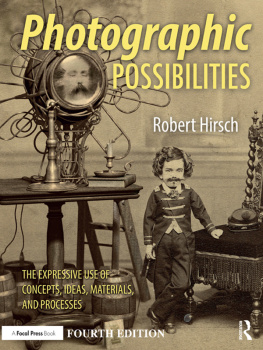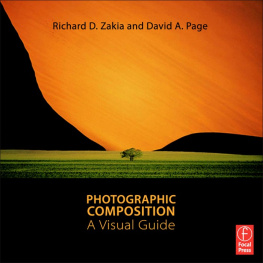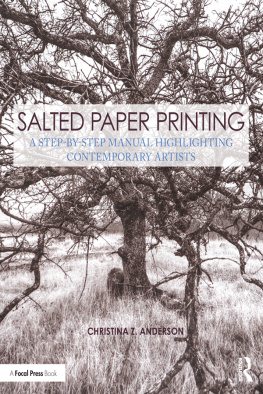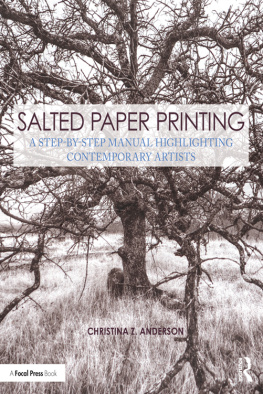Historic Photographic Processes
RICHARD FARBER

Copyright 1998, 2012 by Richard Farber
All rights reserved. Copyright under Berne Copyright Convention, Universal Copyright Convention, and Pan American Copyright Convention. No part of this book may be reproduced, stored in a retrieval system, or transmitted in any form, or by any means, electronic, mechanical, photocopying, recording or otherwise, without the express written consent of the publisher, except in the case of brief excerpts in critical reviews or articles. All inquiries should be addressed to Allworth Press, 307 West 36th Street, 11th Floor, New York, NY 10018.
Allworth Press books may be purchased in bulk at special discounts for sales promotion, corporate gifts, fund-raising, or educational purposes. Special editions can also be created to specifications. For details, contact the Special Sales Department, Allworth Press, 307 West 36th Street, 11th Floor, New York, NY 10018 or
15 14 13 12 115 4 3 2 1
Published by Allworth Press, an imprint of Skyhorse Publishing, Inc. 307 West 36th Street, 11th Floor, New York, NY 10018.
Allworth Press is a registered trademark of Skyhorse Publishing, Inc., a Delaware corporation.
www.allworth.com
Cover design by Douglas Designs, New York, NY
Cover photo 1998 Richard Farber
Book design by Sharp Des!gns, Inc., Lansing, MI
ISBN: 1-880559-93-5
Library of Congress Catalog Card Number: 98-70401
eISBN: 978-1-62153-188-3
This book is dedicated
with love to my parents,
Irving and Sylvia Krone,
and to my wife,
Kathleen Sheridan.
Contents
Acknowledgments
T O THE MANY PEOPLE WHO HELPED WITH THIS BOOK I GIVE MY SINCERE APPRECIATION. I would like to thank Jan van der Schans, who instigated this project; Tad Crawford for easing the obstacles and helping to make this a reality; Kathleen Sheridan for her unwavering support, great line drawings, and for calmly doing a fine editing job in spite of frequent changes; Dr. W. Robert Nix, a true craftsman, for contributing his elegant guest chapter on the bromoil process; Monona Rossol for her invaluable, detailed advice on chemical safety; Dr. Michael Ware for generously sharing his ideas and expertise; Klaus Pollmeier and Suzanne Pastor for making it possible to use a Drtikol image; Dr. Ingeborg Leyerzapf for her enthusiastic support; Harm Botman for generously allowing me the use of his densitometer; and, for believing, Larry Evans.
Introduction
T HE ALTERNATIVE PHOTOGRAPHIC PROCESSES POPULAR TODAY WERE ACTUALLY ON THE cutting edge of yesterdays technology. Although todays photographic technology is certainly easier to use and more convenient than older techniques, many of the historic processes have never been equalled for their appearance, longevity and appeal. Ironically, since computerized output is currently limited to color on resin-coated paper, semipermanent black-and-white prints, or color from inkjet-type printers, the move toward digital or computer-enhanced images has created a new demand for the historic techniques. Being able to make an attractive permanent print, palladium for example, from a digitized negative is surely the best of both worlds. Traditionalists may bemoan the digital age, but the result should be the important thing, not the source, and this fusion between old and new technologies offers exciting possibilities. In a world seemingly dominated by mass-produced items and increasingly sophisticated technology, the historic processes provide a unique means of expression.
To get started with the historic processes, you need only a minimum of equipment and a lot of enthusiasm. Although, as with any interest, a lot of money can be spent on equipment, its perfectly feasible to make a beautiful image using nothing more complicated than a pinhole camera and a piece of glass for a sun printing frame. Many people think a print must be large, but size isnt everything; a special image will speak for itself in its own way, regardless of its size. A well-crafted 4 x 5-inch (10 x 12.5-cm) contact print softly glowing on a beautiful fine-art paper is both elegant and intimate. Most certainly its as much an object of desire and a source of delight as a larger print.
Once you decide to try the historic photographic processes, it will quickly become apparent that for serious information, you need access to either an unusually well-stocked home library or a very good reference section in a local library. In addition, some important books are out of print or difficult to find. And to complicate matters, it can be difficult to find chemicals and measurements in contemporary termscomparing British, American, and metric measurements in drams, ounces, grains, and grams, for example, can be an exercise in frustration. This text has been designed to simplify the processes by making the most important information available, by listing often hard to find resources, by giving standardized measurements and technical terms, and by providing the serious artist with further references.
This book has been designed as a users guide to introduce you as accurately as possible to the historic processes. Since photographers who are interested in these techniques tend to be inquisitive by nature, different variations have been given, when possible, to allow you to compare information and explore possibilities for yourselfto help you discover what works best for you.
The text incorporates information from many sources, which have been liberally cited to encourage further research. These, along with the other texts listed in the bibliography, are highly recommended for further exploration of the historic processes; together they should provide interested readers with answers to most, if not all, of their questions. If you have access to a computer, the Internet is recommended as an unprecedented source of information on a global scale (particularly the archives of alt-photo-process on the Internet). Refer to the appendix for more details.
For the best results with the techniques discussed in this book,
find the characteristics of the materials that youll be using and the safety precautions they require
follow directions carefully
mix formulas in the order given
observe the safety warnings and cautions given in the text
keep good notes
be persistent
always be on the lookout for a great new paper!
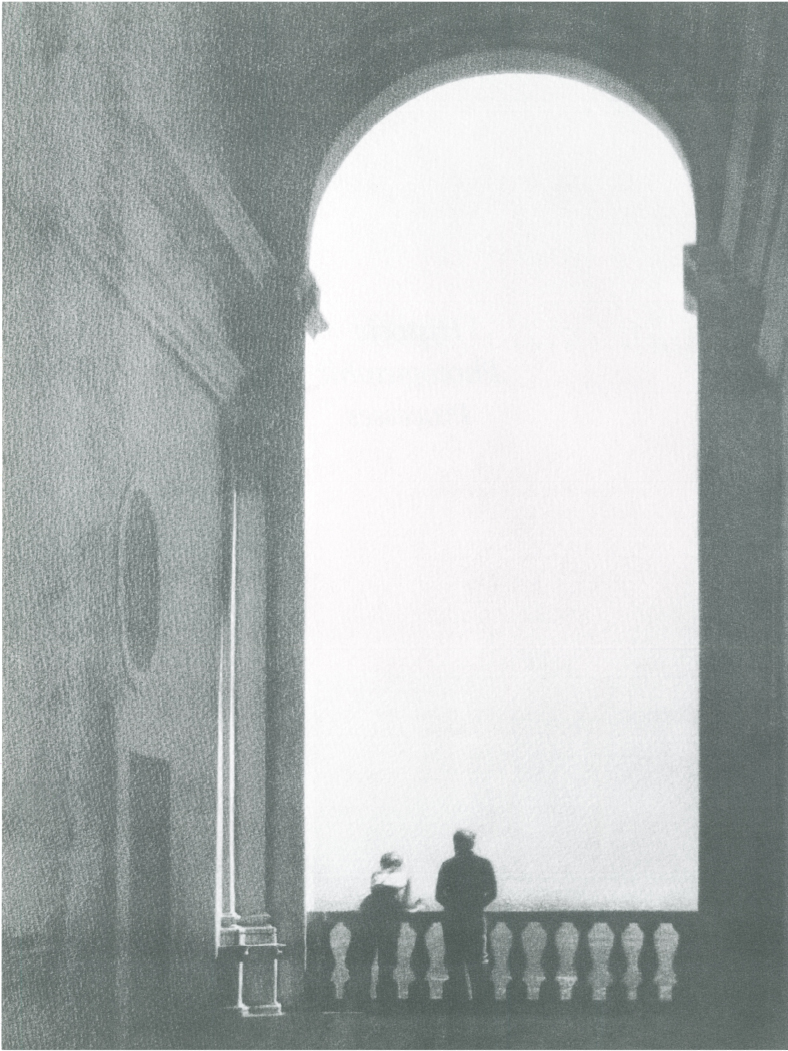
General Applications
Permanence
Probably the most asked question about the processes described in this book, and related processes, concerns the permanence of the image. This is a complex question and not easily answered. The early images were well known for fading, but this was due in part to improper fixing, toning, and washing practices. For all the faded prints, there are many that have survived in fine condition in spite of less-than-optimum processing and storage. The life span of any silver image, however, should be considered finite; how finite is dependent upon many variables, some of which are listed below:
How adequately the print has been fixed and washed.
Whether or not the print has been toned for permanence. Toning greatly prolongs the life of a silver print by combining the vulnerable silver with a more durable substance, such as gold, which is much less affected by environmental conditions.
Where and how the print is stored. The appropriate pH, humidity, and temperature greatly contribute to the survival of the image.

